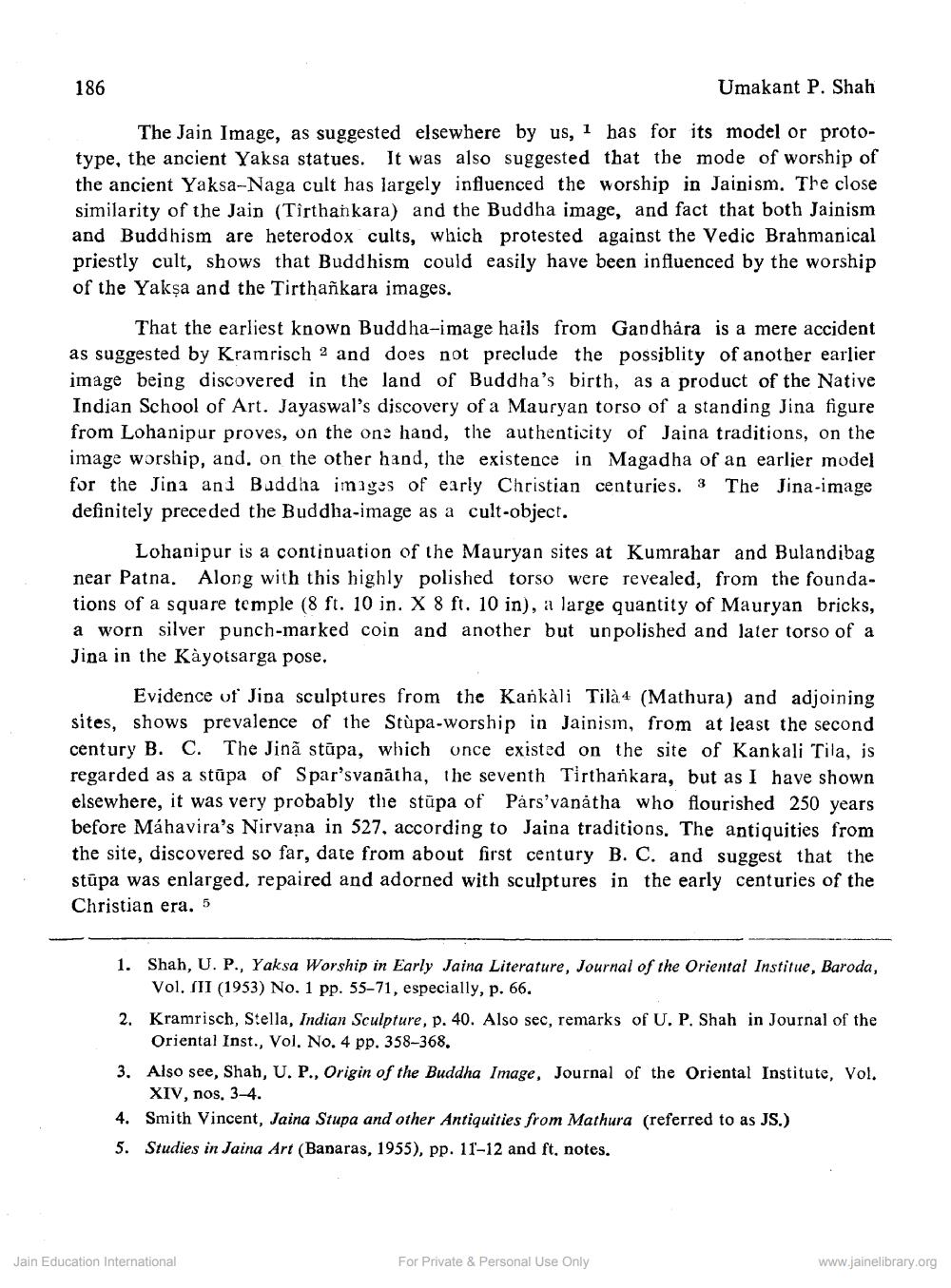________________
Umakant P. Shah
The Jain Image, as suggested elsewhere by us, 1 has for its model or prototype, the ancient Yaksa statues. It was also suggested that the mode of worship of the ancient Yaksa-Naga cult has largely influenced the worship in Jainism. The close similarity of the Jain (Tirthankara) and the Buddha image, and fact that both Jainism. and Buddhism are heterodox cults, which protested against the Vedic Brahmanical priestly cult, shows that Buddhism could easily have been influenced by the worship of the Yaksa and the Tirthankara images.
186
That the earliest known Buddha-image hails from Gandhára is a mere accident as suggested by Kramrisch and does not preclude the possiblity of another earlier image being discovered in the land of Buddha's birth, as a product of the Native Indian School of Art. Jayaswal's discovery of a Mauryan torso of a standing Jina figure from Lohanipur proves, on the one hand, the authenticity of Jaina traditions, on the image worship, and, on the other hand, the existence in Magadha of an earlier model for the Jina and Buddha images of early Christian centuries. 3 The Jina-image definitely preceded the Buddha-image as a cult-object.
Lohanipur is a continuation of the Mauryan sites at Kumrahar and Bulandibag near Patna. Along with this highly polished torso were revealed, from the foundations of a square temple (8 ft. 10 in. X 8 ft. 10 in), a large quantity of Mauryan bricks, a worn silver punch-marked coin and another but unpolished and later torso of a Jina in the Kayotsarga pose.
Evidence of Jina sculptures from the Kankàli Tilà (Mathura) and adjoining sites, shows prevalence of the Stùpa-worship in Jainism, from at least the second. century B. C. The Jina stupa, which once existed on the site of Kankali Tila, is regarded as a stupa of Spar'svanatha, the seventh Tirthankara, but as I have shown. elsewhere, it was very probably the stupa of Pars'vanátha who flourished 250 years before Mahavira's Nirvana in 527, according to Jaina traditions. The antiquities from the site, discovered so far, date from about first century B. C. and suggest that the stupa was enlarged, repaired and adorned with sculptures in the early centuries of the Christian era. 5
1. Shah, U. P., Yaksa Worship in Early Jaina Literature, Journal of the Oriental Institue, Baroda, Vol. III (1953) No. 1 pp. 55-71, especially, p. 66.
2. Kramrisch, Stella, Indian Sculpture, p. 40. Also sec, remarks of U. P. Shah in Journal of the Oriental Inst., Vol. No. 4 pp. 358-368.
3. Also see, Shah, U. P., Origin of the Buddha Image, Journal of the Oriental Institute, Vol. XIV, nos, 3-4.
4. Smith Vincent, Jaina Stupa and other Antiquities from Mathura (referred to as JS.)
5. Studies in Jaina Art (Banaras, 1955), pp. 11-12 and ft. notes.
Jain Education International
For Private & Personal Use Only
www.jainelibrary.org




